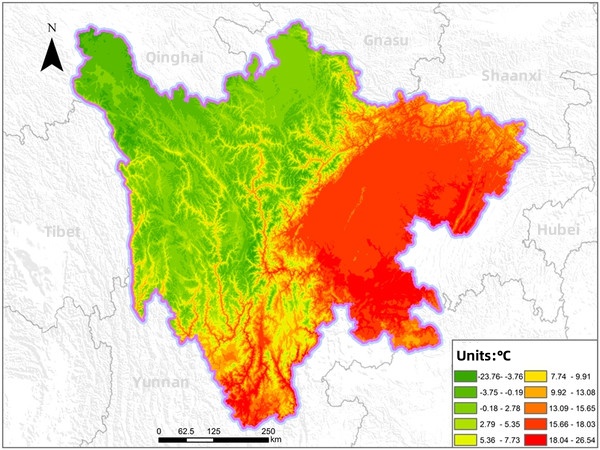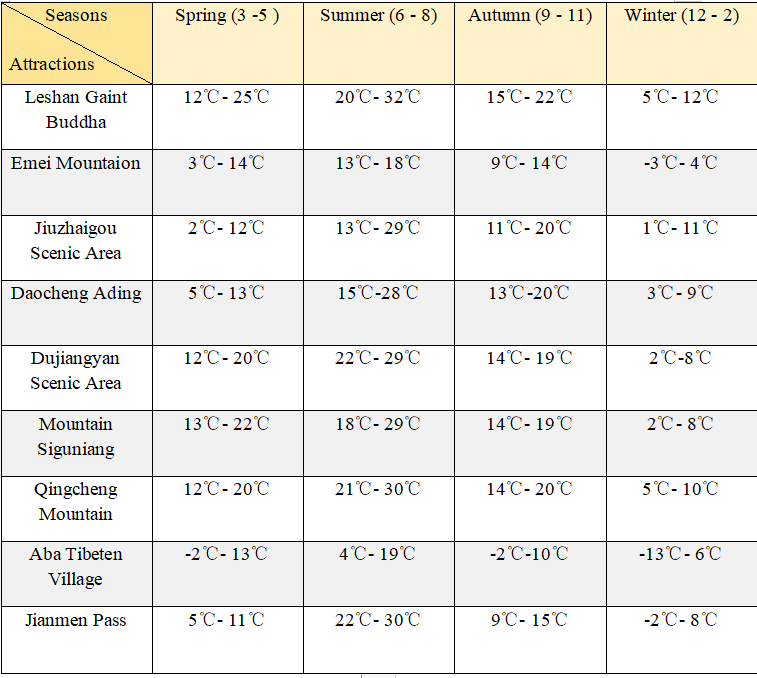Sichuan Province is located in the southwestern part of China, transitioning between subtropical monsoon climate and plateau climate. The average annual temperature varies by region, but a general overview can be provided.
Chengdu, the provincial capital situated in the western Sichuan Basin, experiences an average annual temperature of approximately 16°C to 17°C. Spring is mild and rainy, summer is hot and humid, autumn is cool and dry, and winter is warm with occasional cold spells. Panzhihua, located at the southernmost tip of Sichuan Province, has a higher average annual temperature due to its tropical fringe location, ranging around 20°C to 21°C. Summers here are very hot, while winters are relatively mild. The Ngawa Tibetan and Qiang Autonomous Prefecture and Garze Tibetan Autonomous Prefecture are located west of the Sichuan Basin in high-altitude plateau regions. These areas have lower average annual temperatures. For instance, Jiuzhaigou has an average annual temperature of about 7°C to 8°C, while Daocheng is even lower at around 2°C to 3°C. These regions experience cold winters and cool summers with significant diurnal temperature variations. In summary, Sichuan Province exhibits a noticeable temperature difference from warm in the south to cool in the north. For precise average temperature details, specific meteorological data for each area should be consulted.

From the lush valleys of spring to the crisp heights of winter, Sichuan's climate reflects its geographical diversity and elevational range.
Spring heralds the awakening of Sichuan's landscapes after winter's embrace. Temperatures begin to climb from the coolness of early spring to more moderate levels by late April. In the lowlands and plains, where cities like Chengdu thrive, spring brings mild, comfortable weather ideal for exploring the region's ancient temples and bustling markets. The higher altitudes, such as those in the Tibetan plateau areas of western Sichuan, experience a slower warming trend, with lingering snows melting gradually, feeding into the region's numerous rivers and lakes.
Summer in Sichuan can be characterized as warm and humid, especially in the low-lying areas of the basin. Chengdu, known for its sultry summers, sees temperatures often reaching into the high 20s to low 30s Celsius (80s to 90s Fahrenheit). Higher elevations provide relief with cooler temperatures, making places like Jiuzhaigou and Emei Shan popular destinations for escaping the summer heat. Rainfall increases during this season, nourishing the fertile plains and sustaining Sichuan's reputation as the "Land of Abundance."
Autumn arrives with crispness in the air and a mosaic of colors as leaves turn golden against the backdrop of clear blue skies. The transition from late September to early November is particularly scenic, as Sichuan's countryside transforms into a canvas of red, yellow, and orange hues.
Winter in Sichuan varies widely depending on elevation. Low-lying areas like Chengdu experience mild winters with occasional chilly spells, while higher regions and mountainous areas, including parts of the Tibetan plateau, embrace colder conditions and sometimes heavy snowfall. Temperatures can drop below freezing, particularly at night, creating a winter wonderland in places like the Jiuzhaigou Valley and the snow-capped peaks of the Min Mountains.
Due to Sichuan's varied and complex climate and terrain, different regions exhibit distinct weather characteristics. The climate conditions in different seasons are suitable for different attractions. Below are temperature variation charts for some famous attractions throughout the seasons. Mountainous scenic areas generally have lower temperatures, with cool summers and cold winters





































